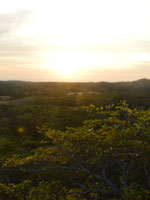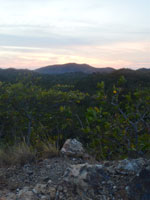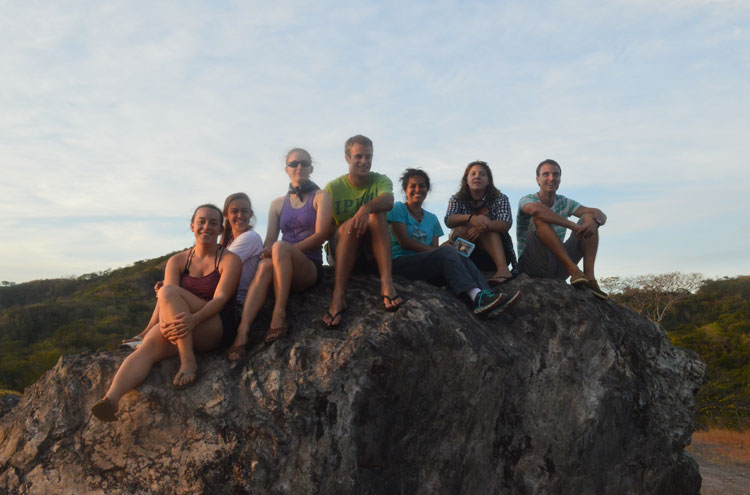

|
This was our last full day at Playa Grande, and a full day it was indeed. We started off with breakfast at Kike's, where Carlos the waiter announced that he had bad news and good news. The bad news was that they were out of orange juice, that actually all of Playa Grande was out of orange juice. The good news was that they had a tamarindo tree in the backyard and they could serve us jugo de tamarindo (tamarindo juice). I decided to forego my usual mango con leche and try the jugo de tamarindo. It was delicious; mixed with ice it tasted like a root beer float. After breakfast, it was nap time and hammock time. After a long night on the beach, it is hard to get continuous sleep in the daytime, so I've been trying to take naps when I have a little bit of free time. Laying in the hammock is also a good way to get some rest, alternately reading a book and sleeping. In the late afternoon, all of the volunteers and biologists headed out for one last excursion, the Sunset Vista. We all piled into the van and drove up to a hill with a rocky outcrop overlooking the vast forested coastal plain that borders the beach. From there we watched our last sunset, a melancholy melange of orange, red, and yellow.  The Leatherback Trust biologists: Lindsay, Heather, Shannon, Chris, Arie, Jenell, and Nathan After sunset we went for our last dinner at Kike's. A sign on the wall reminded of us of how much we enjoyed the past nine days: Good Food, Good Friends Good Times. We joked about the missing comma as we savored the food, and I especially enjoyed my last casado con carne. Then we went back to the station, where we had a couple of hours of naptime before our last night on the beach. We headed out to the beach around 10:45 pm, and this time I was patrolling Playa Ventanas with Jenell. We stopped at the Hatchery on the way out and picked up a bucket full of Leatherback hatchlings that were ready for release. We carried them up Playa Grande, then went through the gateway marked by the offshore rock and into the sublime isolation of Playa Ventanas. We found a place in the middle of the beach and gently tipped over the bucket. The leatherbacks were much more vigorous than the olive ridley hatchlings we had released the night before and they rapidly made their way to the surf line. They were a little bit heftier too, so when a big wave came, it was more likely to carry them out to sea, rather than wash them further up on the beach. Elsewhere on the beach, it was a quiet night, with little communication coming in over the radio. There was a call about a leatherback at marker #25, but it turned out to be a "false crawl." The baula headed back out to the ocean so we did not get a chance to "work her." The radio communication gave me a chance to learn some very arcane Spanish though, as I listened to the biologists talking back and forth. I often heard them respond to a call with the word "dos," which means the number two in Spanish. This is police radio talk, the Spanish equivalent of "10-4, copy that." Jenell and I patrolled Playa Ventanas for more than six hours, making four round trips from the Hatchery to the northern end of Ventanas. We would take short breaks at each end of the patrol, but it was still a lot of walking, a total of 12 kilometers (8 miles). As we sat at the northern end of Playa Ventanas, I realized that we were just a few feet away from where Nathan and I had spotted crocodile tracks a few days before. Jenell just laughed; she wasn't afraid. She is doing a study on crocodiles and the effect of salinity levels on their health. I think she rather relished the thought of one of the big crocs coming around to greet us. After our break, we headed back south down the beach. There was an unusually large amount of bioluminescent material washing ashore that night and the waves were shining with a bright white glow as they crested. As we walked, our footprints sunk down into the sand and lit up with a phosphorescent glow as well. Jenell walked faster than me, but I didn't have to worry about losing her; I could just follow the glowing footprints. When we got back to the rock at the gateway to Playa Ventanas, it was high tide. The gateway was completely underwater and we had to make our way over the rocks at the edge of the beach, timing it so we could race across the rocks as the waves receded. After the last break at the northern end of Playa Ventanas, it was almost morning. The howler monkeys were out in force, calling out from the forest with their cries that sound like they are coming from the depths of hell. It was the loudest I had heard them and they sounded like they were very close. Jenell called out to them with her own howler monkey roar, and they immediately responded. It was an invigorating way to greet the dawn. |
||||
|
||||
|
© 2015 Michael Hanrahan
|